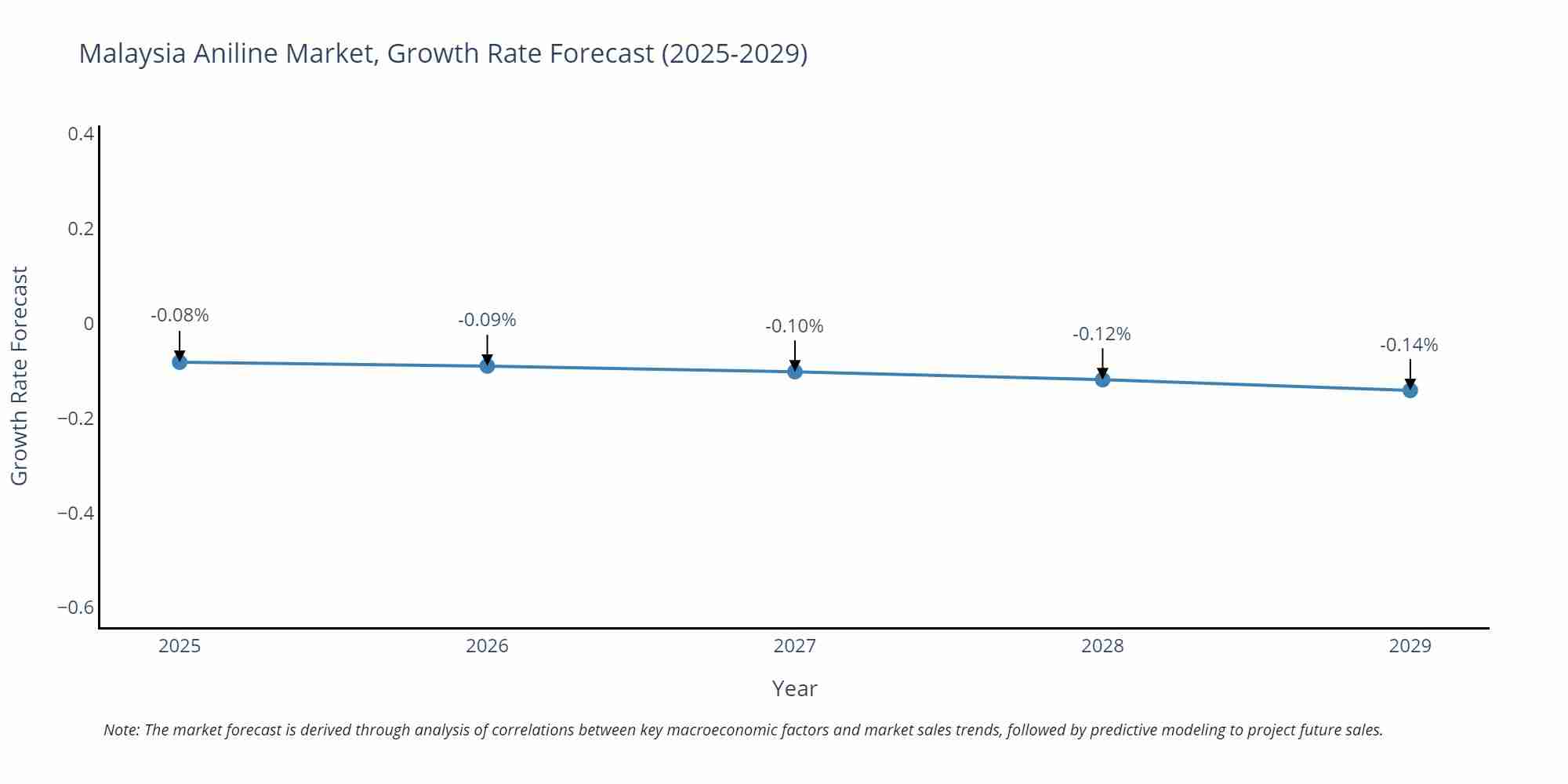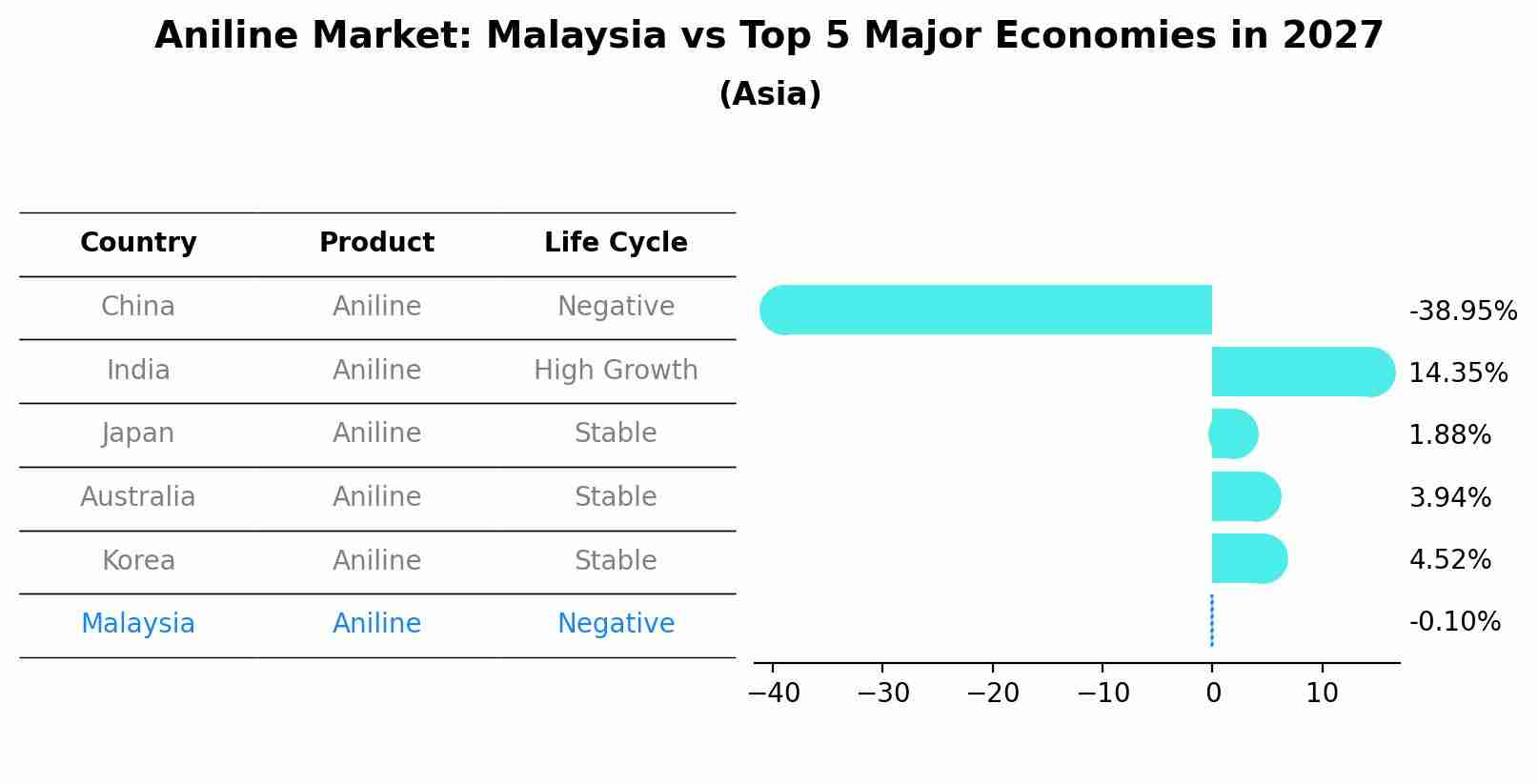Malaysia Aniline Market (2025-2031) Outlook | Analysis, Trends, Value, Forecast, Revenue, Share, Size, Industry, Companies & Growth
| Product Code: ETC094965 | Publication Date: Jun 2021 | Updated Date: Apr 2025 | Product Type: Report | |
| Publisher: 6Wresearch | No. of Pages: 70 | No. of Figures: 35 | No. of Tables: 5 | |
Malaysia Aniline Market Size Growth Rate
The Malaysia Aniline Market may undergo a gradual slowdown in growth rates between 2025 and 2029. Beginning strongly at -0.08% in 2025, growth softens to -0.14% in 2029.

Aniline Market: Malaysia vs Top 5 Major Economies in 2027 (Asia)
By 2027, Malaysia's Aniline market is forecasted to achieve a negative growth rate of -0.10%, with China leading the Asia region, followed by India, Japan, Australia and South Korea.

Malaysia Aniline Market Synopsis
The aniline market in Malaysia was estimated at USD 15.3 million in 2025 and is expected to reach USD 18.2 million by 2025, growing at a CAGR of 3.3%.The major drivers of the aniline market are the growing demand from industries such as chemicals, polyurethanes resins, dyes & pigments and pesticides for their respective applications. The increasing consumer preference towards low VOC (Volatile Organic Compounds) products is also driving the growth of this industry in Malaysia.
Market Drivers of the market
The Malaysia Aniline market is expected to experience moderate growth in the upcoming years, driven by its applications in the production of various chemicals and dyes. Aniline is a vital precursor for many industrial chemicals, including MDI (methylene diphenyl diisocyanate) and rubber additives. The automotive and construction industries, which extensively use MDI, contribute to the demand for aniline. Moreover, the increasing demand for dyestuffs in the textile industry further fuels the growth of the aniline market in Malaysia.
Challenges of the market
The Malaysia Aniline market encounters challenges related to its chemical properties and safety concerns. Aniline is a toxic substance, and its handling requires strict safety measures to protect workers and the environment. Ensuring proper handling, storage, and disposal of aniline is crucial to prevent accidents and minimize environmental impacts. Regulatory compliance and implementation of safety protocols are essential to address these challenges.
Covid-19 Impact on the market
The Malaysia Aniline market encountered challenges during the COVID-19 pandemic. With several industries facing temporary closures and disruptions in manufacturing operations, the demand for aniline-derived products, such as MDI for the construction and automotive sectors, experienced a downturn. The pharmaceutical and dye industries, which also utilize aniline, faced disruptions in supply chains and logistics, impacting the production of medicines and dyestuffs. However, as restrictions eased, industries gradually resumed operations, leading to a recovery in demand for aniline-based products. The market had to navigate through the uncertainties and demand fluctuations caused by the pandemic.
Key Players of the market
The Malaysia aniline market is projected to show moderate growth in the forecast period. Aniline is a key chemical used in the production of various products such as dyes, rubber additives, and pharmaceuticals. Major players like AnilineMakers Sdn Bhd, ColorChem Industries, and AnilinePlus are expected to play a crucial role in driving market growth. These companies might focus on sustainability practices and innovation to meet regulatory requirements and customer demands.
Key Highlights of the Report:
- Malaysia Aniline Market Outlook
- Market Size of Malaysia Aniline Market, 2024
- Forecast of Malaysia Aniline Market, 2031
- Historical Data and Forecast of Malaysia Aniline Revenues & Volume for the Period 2021-2031
- Malaysia Aniline Market Trend Evolution
- Malaysia Aniline Market Drivers and Challenges
- Malaysia Aniline Price Trends
- Malaysia Aniline Porter's Five Forces
- Malaysia Aniline Industry Life Cycle
- Historical Data and Forecast of Malaysia Aniline Market Revenues & Volume By Product Type for the Period 2021-2031
- Historical Data and Forecast of Malaysia Aniline Market Revenues & Volume By Synthetic Aniline for the Period 2021-2031
- Historical Data and Forecast of Malaysia Aniline Market Revenues & Volume By Bio-Based Aniline for the Period 2021-2031
- Historical Data and Forecast of Malaysia Aniline Market Revenues & Volume By Application for the Period 2021-2031
- Historical Data and Forecast of Malaysia Aniline Market Revenues & Volume By Methylene Diphenyl Diisocyanate (MDI) for the Period 2021-2031
- Historical Data and Forecast of Malaysia Aniline Market Revenues & Volume By Others for the Period 2021-2031
- Historical Data and Forecast of Malaysia Aniline Market Revenues & Volume By Industry Vertical for the Period 2021-2031
- Historical Data and Forecast of Malaysia Aniline Market Revenues & Volume By Building & Construction for the Period 2021-2031
- Historical Data and Forecast of Malaysia Aniline Market Revenues & Volume By Rubber for the Period 2021-2031
- Historical Data and Forecast of Malaysia Aniline Market Revenues & Volume By Consumer Goods for the Period 2021-2031
- Historical Data and Forecast of Malaysia Aniline Market Revenues & Volume By Automotive for the Period 2021-2031
- Historical Data and Forecast of Malaysia Aniline Market Revenues & Volume By Packaging for the Period 2021-2031
- Historical Data and Forecast of Malaysia Aniline Market Revenues & Volume By Agriculture for the Period 2021-2031
- Historical Data and Forecast of Malaysia Aniline Market Revenues & Volume By Others for the Period 2021-2031
- Malaysia Aniline Import Export Trade Statistics
- Market Opportunity Assessment By Product Type
- Market Opportunity Assessment By Application
- Market Opportunity Assessment By Industry Vertical
- Malaysia Aniline Top Companies Market Share
- Malaysia Aniline Competitive Benchmarking By Technical and Operational Parameters
- Malaysia Aniline Company Profiles
- Malaysia Aniline Key Strategic Recommendations
Frequently Asked Questions About the Market Study (FAQs):
1 Executive Summary |
2 Introduction |
2.1 Key Highlights of the Report |
2.2 Report Description |
2.3 Market Scope & Segmentation |
2.4 Research Methodology |
2.5 Assumptions |
3 Malaysia Aniline Market Overview |
3.1 Malaysia Country Macro Economic Indicators |
3.2 Malaysia Aniline Market Revenues & Volume, 2021 & 2031F |
3.3 Malaysia Aniline Market - Industry Life Cycle |
3.4 Malaysia Aniline Market - Porter's Five Forces |
3.5 Malaysia Aniline Market Revenues & Volume Share, By Product Type, 2021 & 2031F |
3.6 Malaysia Aniline Market Revenues & Volume Share, By Application, 2021 & 2031F |
3.7 Malaysia Aniline Market Revenues & Volume Share, By Industry Vertical, 2021 & 2031F |
4 Malaysia Aniline Market Dynamics |
4.1 Impact Analysis |
4.2 Market Drivers |
4.3 Market Restraints |
5 Malaysia Aniline Market Trends |
6 Malaysia Aniline Market, By Types |
6.1 Malaysia Aniline Market, By Product Type |
6.1.1 Overview and Analysis |
6.1.2 Malaysia Aniline Market Revenues & Volume, By Product Type, 2021-2031F |
6.1.3 Malaysia Aniline Market Revenues & Volume, By Synthetic Aniline, 2021-2031F |
6.1.4 Malaysia Aniline Market Revenues & Volume, By Bio-Based Aniline, 2021-2031F |
6.2 Malaysia Aniline Market, By Application |
6.2.1 Overview and Analysis |
6.2.2 Malaysia Aniline Market Revenues & Volume, By Methylene Diphenyl Diisocyanate (MDI), 2021-2031F |
6.2.3 Malaysia Aniline Market Revenues & Volume, By Others, 2021-2031F |
6.3 Malaysia Aniline Market, By Industry Vertical |
6.3.1 Overview and Analysis |
6.3.2 Malaysia Aniline Market Revenues & Volume, By Building & Construction, 2021-2031F |
6.3.3 Malaysia Aniline Market Revenues & Volume, By Rubber, 2021-2031F |
6.3.4 Malaysia Aniline Market Revenues & Volume, By Consumer Goods, 2021-2031F |
6.3.5 Malaysia Aniline Market Revenues & Volume, By Automotive, 2021-2031F |
6.3.6 Malaysia Aniline Market Revenues & Volume, By Packaging, 2021-2031F |
6.3.7 Malaysia Aniline Market Revenues & Volume, By Agriculture, 2021-2031F |
7 Malaysia Aniline Market Import-Export Trade Statistics |
7.1 Malaysia Aniline Market Export to Major Countries |
7.2 Malaysia Aniline Market Imports from Major Countries |
8 Malaysia Aniline Market Key Performance Indicators |
9 Malaysia Aniline Market - Opportunity Assessment |
9.1 Malaysia Aniline Market Opportunity Assessment, By Product Type, 2021 & 2031F |
9.2 Malaysia Aniline Market Opportunity Assessment, By Application, 2021 & 2031F |
9.3 Malaysia Aniline Market Opportunity Assessment, By Industry Vertical, 2021 & 2031F |
10 Malaysia Aniline Market - Competitive Landscape |
10.1 Malaysia Aniline Market Revenue Share, By Companies, 2024 |
10.2 Malaysia Aniline Market Competitive Benchmarking, By Operating and Technical Parameters |
11 Company Profiles |
12 Recommendations |
13 Disclaimer |
- Single User License$ 1,995
- Department License$ 2,400
- Site License$ 3,120
- Global License$ 3,795
Search
Related Reports
- Australia IT Asset Disposal Market (2025-2031) | Strategy, Consumer Insights, Analysis, Investment Trends, Opportunities, Growth, Size, Share, Industry, Revenue, Segments, Value, Segmentation, Supply, Forecast, Restraints, Outlook, Competition, Drivers, Trends, Demand, Pricing Analysis, Competitive, Strategic Insights, Companies, Challenges
- UAE Building Thermal Insulation Market Outlook (2025-2031) | Revenue, Companies, Share, Trends, Growth, Size, Forecast, Industry, Analysis & Value
- Portugal Electronic Document Management Market (2025-2031) | Strategy, Consumer Insights, Analysis, Investment Trends, Opportunities, Growth, Size, Share, Industry, Revenue, Segments, Value, Segmentation, Supply, Forecast, Restraints, Outlook, Competition, Drivers, Trends, Demand, Pricing Analysis, Competitive, Strategic Insights, Companies, Challenges
- France Electronic Document Management Market (2025-2031) | Strategy, Consumer Insights, Analysis, Investment Trends, Opportunities, Growth, Size, Share, Industry, Revenue, Segments, Value, Segmentation, Supply, Forecast, Restraints, Outlook, Competition, Drivers, Trends, Demand, Pricing Analysis, Competitive, Strategic Insights, Companies, Challenges
- Portugal Occupational Health & Safety Services Market (2025-2031) | Strategy, Consumer Insights, Analysis, Investment Trends, Opportunities, Growth, Size, Share, Industry, Revenue, Segments, Value, Segmentation, Supply, Forecast, Restraints, Outlook, Competition, Drivers, Trends, Demand, Pricing Analysis, Competitive, Strategic Insights, Companies, Challenges
- Netherlands Occupational Health and Safety Services Market (2025-2031) | Strategy, Consumer Insights, Analysis, Investment Trends, Opportunities, Growth, Size, Share, Industry, Revenue, Segments, Value, Segmentation, Supply, Forecast, Restraints, Outlook, Competition, Drivers, Trends, Demand, Pricing Analysis, Competitive, Strategic Insights, Companies, Challenges
- Belgium and Luxembourg Facility Management Market (2025-2031) | Strategy, Consumer Insights, Analysis, Investment Trends, Opportunities, Growth, Size, Share, Industry, Revenue, Segments, Value, Segmentation, Supply, Forecast, Restraints, Outlook, Competition, Drivers, Trends, Demand, Pricing Analysis, Competitive, Strategic Insights, Companies, Challenges
- Russia Women Intimate Apparel Market (2025-2031) | Strategy, Consumer Insights, Analysis, Investment Trends, Opportunities, Growth, Size, Share, Industry, Revenue, Segments, Value, Segmentation, Supply, Forecast, Restraints, Outlook, Competition, Drivers, Trends, Demand, Pricing Analysis, Competitive, Strategic Insights, Companies, Challenges
- Africa Chocolate Market (2025-2031) | Size, Share, Trends, Growth, Revenue, Analysis, Forecast, industry & Outlook
- Global Hydroxychloroquine And Chloroquine Market (2025-2031) | Industry, Trends, Size, Outlook, Growth, Value, Companies, Revenue, Analysis, Share, Forecast
Industry Events and Analyst Meet
Our Clients
Whitepaper
- Middle East & Africa Commercial Security Market Click here to view more.
- Middle East & Africa Fire Safety Systems & Equipment Market Click here to view more.
- GCC Drone Market Click here to view more.
- Middle East Lighting Fixture Market Click here to view more.
- GCC Physical & Perimeter Security Market Click here to view more.
6WResearch In News
- Doha a strategic location for EV manufacturing hub: IPA Qatar
- Demand for luxury TVs surging in the GCC, says Samsung
- Empowering Growth: The Thriving Journey of Bangladesh’s Cable Industry
- Demand for luxury TVs surging in the GCC, says Samsung
- Video call with a traditional healer? Once unthinkable, it’s now common in South Africa
- Intelligent Buildings To Smooth GCC’s Path To Net Zero













